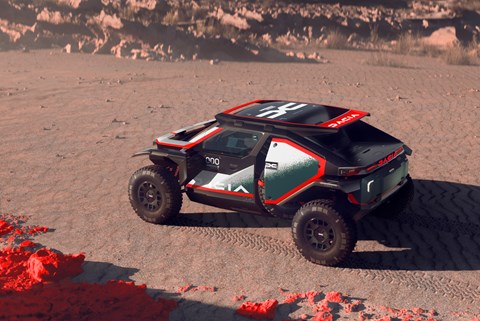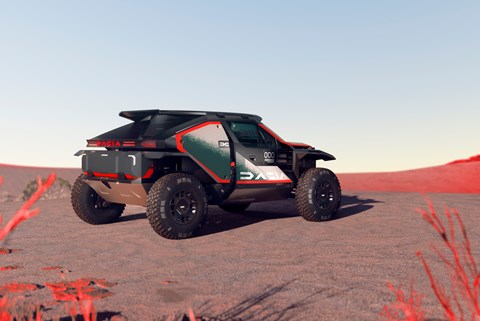► Dacia’s entering Dakar with new Sandrider
► Manifesto concept-inspired design
► We hitch a wild ride on the rally raider
Dacia is doubling down on its rugged, outdoorsy image – a strategy underlined by this, the new 2024 Dacia Sandrider race car. It’s a rough ‘n’ tough Dakar rally raider and we’ve hitched a lift during testing to experience the wild design and engineering first hand.
Watch our exclusive film above, as head of video James Dennison meets its makers and holds on for dear life as the Sandrider shows off its extraordinary flight skills and trick suspension.
Dacia revealed its 2025-and-beyond World Rally Raid and Dakar Rally contender at the 2024 Geneva motor show. The brand, which has partnered up with Prodrive, says the new, tough off-roader is ‘a prototype designed to win’ and will run in the Ultimate T1+ FIA class.
The new Sandrider’s design is heavily inspired by the Manifesto concept. In fact, Dacia’s chief designer of its Advanced Design division, Romain Gauvin, tells us the two cars were designed in parallel. ‘We absolutely did not want to take an existing production car like a Duster or a Spring or something and deform it on top of a Dakar chassis – it doesn’t make sense in terms of functionality,’ he says.

‘The Dakar project was under the radar for a bit of time, but when we started working on it we were also working on the Manifesto,’ adds Gauvin, ‘so they stem from the same movement – it was a good starting point.’ So much so that, like the Manifesto, Dacia says the only body panels fitted to the Sandrider are ones that are absolutely necessary.
A lot of the car’s design development was aided by intel and guidance gathered by the upcoming Dacia team’s drivers. ‘We were directly in contact,’ Gauvin tells us. ‘The drivers and co-drivers have a very deep knowledge of their car, so they were great people to talk to in order to collect info on what it is they really need.’

Design details like a raked bonnet in order not to obstruct the driver’s field of view, as well as a magnetic plate for ensuring fixing bolts don’t get lost in the sand feature – influenced by the drivers and co-drivers. ‘Take the visibility for instance; having a few more degrees of visibility means they can anticipate more and feel safer, meaning you can take more risks to squeeze out a few seconds,’ says Gauvin.
Dacia’s approach to keeping things simple has extended to aerodynamics and weight, too. Dacia claims that its focus on simplicity means the Sandrider is 15kg lighter as well as benefitting from reduced drag by 10 per cent and lift by 40 per cent ‘in relation to comparable prototypes.’ Anti-infrared pigments in the paint and special fabrics used inside are designed to reduce heat in the cabin.

The Sandrider relies on a 3.0-litre twin-turbo V6 powertrain developing 355bhp and 398lb ft, with power sent to all four wheels via a six-speed sequential. Crucially, though, the Sandrider will run exclusively on synthetic fuel by Aramco.
Three crews will drive the Sandrider in its first Dakar entry in 2025. The Dacia team will headlined by Sébastien Loeb and co-driver Fabian Lurquin, and will include Cristina Gutierrez Herrero and her co-driver Pablo Moreno Huete as well as Nasser Al-Attiyah and co-driver Mathieu Baumel.
Development kickstarts as of now, including tests in several countries around the world. Dacia says the Sandrider’s motorsport debut will be at the Rallye du Maroc in 2024.